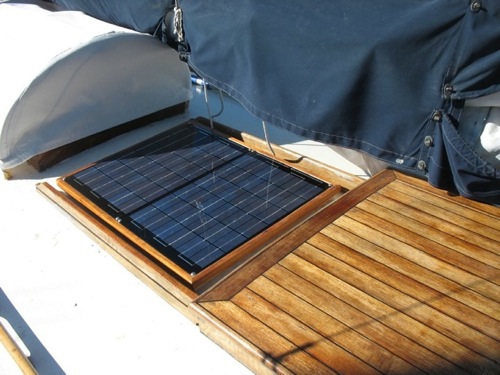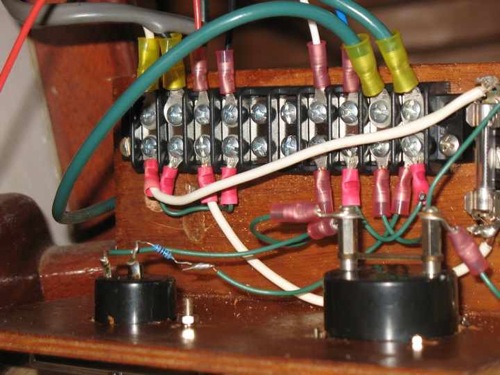
Page 1 Page 2 Page 3 Page 4 Page 5 Page 6
1-15-9
Further Improvements

First, is a picture of the wiring for the volt meter and ammeter. There were no changes from before. The ammeter can display up to 15 amps. The terminals are listed from left to right as follows:
Solar panel input
Output to charge controller
Not used
Input from charge controller
Output to battery
The ammeter and volt meter indicate the power after it has gone through the charge controller. There are a couple of fuses to protect things from a current surge or a short.
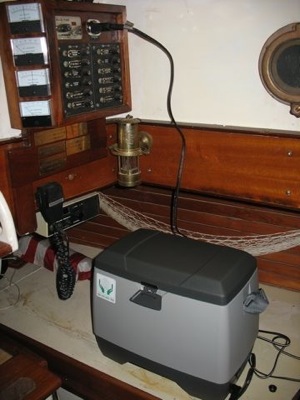 I
decided expand the use of the 12 volt DC plugin. I wanted to use it
for things like a battery charger for those AA batteries that the
hand held VHF requires. I also purchased a portable refrigerator
cooler. I also purchased an inverter for use with a laptop. All of
these things use power. The reefer uses 2 to 3 amps depending on its
setting. The battery charger uses maybe a quarter amp at most. The
laptop uses 2 to 4 amps. All of these, particularly the reefer are a
big drag on the battery. The little 12 watt panel would be hard
pressed to recharge a mostly depleted battery by the time I returned
the next weekend. Also leaving a battery highly discharged tends to
shorten its life.
I
decided expand the use of the 12 volt DC plugin. I wanted to use it
for things like a battery charger for those AA batteries that the
hand held VHF requires. I also purchased a portable refrigerator
cooler. I also purchased an inverter for use with a laptop. All of
these things use power. The reefer uses 2 to 3 amps depending on its
setting. The battery charger uses maybe a quarter amp at most. The
laptop uses 2 to 4 amps. All of these, particularly the reefer are a
big drag on the battery. The little 12 watt panel would be hard
pressed to recharge a mostly depleted battery by the time I returned
the next weekend. Also leaving a battery highly discharged tends to
shorten its life.
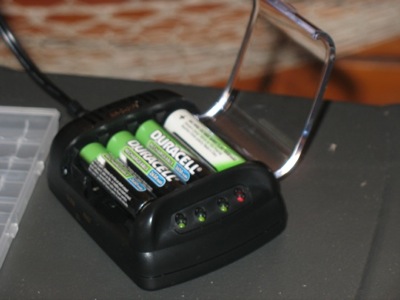 As
I did previously I wanted to make sure the solar panel was on a firm
foundation so that I could step on it without breaking or damaging
it. I also wanted to allow air to circulate beneath it. I also needed
room for the wiring. I ended up purchasing two 12 volt 24 watt
Sunwise Solchargers. These are built up on a substrate of FR4 so
there is no glass to possibly break. I then constructed the mount
using 3/8” occoume plywood. I used sleepers that are curved to
conform to the curve of the cabin top. I mounted this assembly with 8
through bolts to keep it in place more securely.
As
I did previously I wanted to make sure the solar panel was on a firm
foundation so that I could step on it without breaking or damaging
it. I also wanted to allow air to circulate beneath it. I also needed
room for the wiring. I ended up purchasing two 12 volt 24 watt
Sunwise Solchargers. These are built up on a substrate of FR4 so
there is no glass to possibly break. I then constructed the mount
using 3/8” occoume plywood. I used sleepers that are curved to
conform to the curve of the cabin top. I mounted this assembly with 8
through bolts to keep it in place more securely.
I wired the panels in parallel. This allows one panel to still operate if the other one is in shadow. The shadowed panel may put out a smaller voltage but there appears to be no significant current flowing backwards through it.
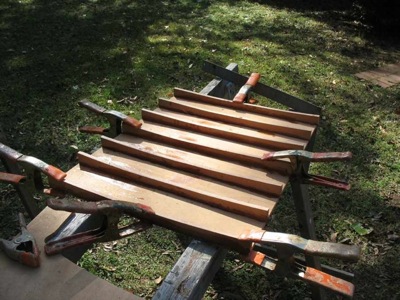 Preliminary
results show that it is adequately charging the battery. However, I
moved the boat to a new dock. The panels are not as exposed to the
sun in this new dock so some of the gain of going from 12 watts to 48
watts is lost. But in general it is still a 2 to 3 fold improvement
in charging capacity. A quick test on a clear morning with the sun at
about 30 degrees up in the sky and the panels fully exposed showed an
output of around 2 amps.
Preliminary
results show that it is adequately charging the battery. However, I
moved the boat to a new dock. The panels are not as exposed to the
sun in this new dock so some of the gain of going from 12 watts to 48
watts is lost. But in general it is still a 2 to 3 fold improvement
in charging capacity. A quick test on a clear morning with the sun at
about 30 degrees up in the sky and the panels fully exposed showed an
output of around 2 amps.
